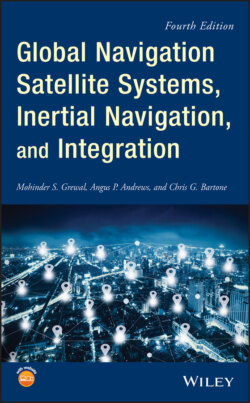Читать книгу Global Navigation Satellite Systems, Inertial Navigation, and Integration - Mohinder S. Grewal - Страница 141
3.6.2.2 Strapdown Navigation Propagation
ОглавлениеThe basic signal processing functions for strapdown INS navigation are illustrated in Figure 3.21, where
G is the estimated gravitational acceleration, computed as a function of estimated position.
is the estimated position of the host vehicle in navigation coordinates.
is the estimated velocity of the host vehicle in navigation coordinates.
is the estimated acceleration of the host vehicle in navigation coordinates, which may be used for trajectory control (i.e. vehicle guidance).
is the estimated acceleration of the host vehicle in sensor‐fixed coordinates, which may be used for vehicle steering stabilization and control.
is the coordinate transformation matrix from sensor‐fixed coordinates to navigation coordinates, representing the attitude of the sensors in navigation coordinates.
is the estimated angular velocity of the host vehicle in sensor‐fixed (ISA) coordinates, which may be used for vehicle attitude stabilization and control.
is the estimated angular velocity of the host vehicle in navigation coordinates, which may be used in a vehicle pointing and attitude control loop.
Figure 3.21 Essential navigation signal processing for strapdown INS.
The essential processing functions include double integration (represented by boxes containing integration symbols) of acceleration to obtain position, and computation of (unsensed) gravitational acceleration as a function of position. The sensed angular rates also need to be integrated to maintain the knowledge of sensor attitudes. The initial values of all the integrals (i.e. position, velocity, and attitude) must also be known before integration can begin.
The position vector is the essential navigation solution. The other outputs shown are not needed for all applications, but most of them (except ) are intermediate results that are available “for free” (i.e. without requiring further processing). The velocity vector , for example, characterizes speed and heading, which are also useful for correcting the course of the host vehicle to bring it to a desired location. Most of the other outputs shown would be required for implementing control of an unmanned or autonomous host vehicle to follow a desired trajectory and/or to bring the host vehicle to a desired final position.
Navigation functions that are not shown in Figure 3.21 include:
1 How initialization of the integrals for position, velocity, and attitude is implemented. Initial position and velocity can be input from other sources (GNSS, for example), and attitude can be inferred from some form of trajectory matching (using GPS, for example) or by gyrocompassing.
2 How attitude rates are integrated to obtain attitude, described in Section 3.6.1.1.
3 For the case that navigation coordinates are Earth‐fixed, the computation of navigational coordinate rotation due to earthrate as a function of position, and its summation with sensed rates before integration.
4 For the case that navigation coordinates are locally‐level, the computation includes the rotation rate of navigation coordinates due to vehicle horizontal velocity and its summation with sensed rates before integration.
5 Calibration of the sensors for error compensation. If the errors are sufficiently stable, it needs to be done only once. Otherwise, it can be implemented using the GNSS/INS integration techniques discussed in Chapter 12.
Figure 3.22 is a process flow diagram for the same implementation, arranged such that the variables available for other functions is around the periphery. These are the sorts of variables that might be needed for driving cockpit displays, antennas, weaponry, sensors, or other surveillance assets.
